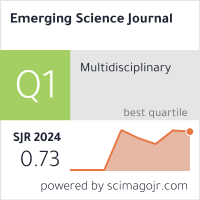Bayesian Estimation for Zero-Truncated Bivariate Poisson Regression Model
Downloads
Bivariate count data occurs when two associated variable counts necessitate joint estimate primarily for efficiency purposes. This paper presents Bayesian estimate for the zero-truncated bivariate Poisson regression model. This bivariate model was established using marginal-conditional models. Bayes estimators were executed utilizing the random walk Metropolis-Hastings algorithm with two distinct prior distributions: Laplace and normal distributions. Moreover, estimators employing the bootstrap approach were proposed. Additionally, the credible intervals and the percentile bootstrap confidence intervals were analyzed. The performance of the Bayes estimators was compared with that of the bootstrap estimators and the maximum likelihood estimators via a Monte Carlo simulation analysis, focusing on mean square error. The performance of intervals was evaluated based on coverage probability and average length. Furthermore, the explanatory variables were produced under conditions of both multicollinearity and a lack of multicollinearity. Two empirical datasets were examined to demonstrate the practical use of the suggested model and methodology. The findings from both the simulation and application indicate that the Bayesian method with a normal prior distribution surpasses alternative methods.
Downloads
[1] Lerdsuwansri, R., Phonsrirat, C., Prawalwanna, P., Wongsai, N., Wongsai, S., & Simmachan, T. (2022). Road traffic injuries in Thailand and their associated factors using Conway–Maxwell–Poisson regression model. Thai Journal of Mathematics, Special Issue: The 17th IMT‑GT ICMSA 2021, 240–249.
[2] Simmachan, T., Wongsai, N., Wongsai, S., & Lerdsuwansri, R. (2022). Modeling road accident fatalities with underdispersion and zero‑inflated counts. PLoS ONE, 17(11), e0309234. doi:10.1371/journal.pone.0269022.
[3] Jung, R. C., & Winkelmann, R. (1993). Two aspects of labor mobility: A bivariate Poisson regression approach. Empirical Economics, 18(3), 543–556. doi:10.1007/BF01176203.
[4] Ho, L. L., & Singer, J. M. (1997). Regression models for bivariate counts. Brazilian Journal of Probability and Statistics, 11(2), 175–197.
[5] Kocherlakota, S., & Kocherlakota, K. (2001). Regression in the bivariate Poisson distribution. Communications in Statistics – Theory and Methods, 30(5), 815–825. doi:10.1081/STA‑100002259.
[6] Famoye, F. (2012). Comparisons of some bivariate regression models. Journal of Statistical Computation and Simulation, 82(7), 937–949. doi:10.1080/00949655.2010.543679.
[7] AlMuhayfith, F. E., Alzaid, A. A., & Omair, M. A. (2016). On bivariate Poisson regression models. Journal of King Saud University – Science, 28(2), 178–189. doi:10.1016/j.jksus.2015.09.003.
[8] Qarmalah, N., & Alzaid, A. A. (2023). Zero‑dependent divariate Poisson distribution with applications. Mathematics, 11(5), 1194. doi:10.3390/math11051194.
[9] Leiter, R. E., & Hamdan, M. A. (1973). Some bivariate probability models applicable to traffic accidents and fatalities. International Statistical Review, 41(1), 87–100. doi:10.2307/1402790.
[10] Islam, M. A., & Chowdhury, R. I. (2015). A bivariate Poisson models with covariate dependence. Bulletin of Calcutta Mathematical Society, 107(1), 11–20.
[11] Chowdhury, R. I., & Islam, M. A. (2016). Zero truncated bivariate Poisson model: Marginal‑conditional modeling approach with an application to traffic accident data. Applied Mathematics, 7(14), 1589–1598. doi:10.4236/am.2016.714137.
[12] Wang, S., Chen, W., Chen, M., & Zhou, Y. (2023). Maximum likelihood estimation of the parameters of the inverse Gaussian distribution using maximum rank set sampling with unequal samples. Mathematical Population Studies, 30(1), 1–21. doi:10.1080/08898480.2021.1996822.
[13] Kummaraka, U., & Srisuradetchai, P. (2023). Interval estimation of the dependence parameter in bivariate Clayton copulas. Emerging Science Journal, 7(5), 1478–1490. doi:10.28991/ESJ-2023-07-05-02.
[14] Chaipitak, S., & Choopradit, B. (2024). A new test for equality of two covariance matrices in high-dimensional data. Mathematics and Statistics, 12(5), 455–464. doi:10.13189/ms.2024.120507.
[15] Sudjai, N., Duangsaphon, M., & Chandhanayingyong, C. (2024). Impact of the power of adaptive weight on penalized logistic regression: Application to adipocytic tumors classification. Journal of Biostatistics and Epidemiology, 10(3), 253–272. doi:10.18502/jbe.v10i3.17922.
[16] Efron, B., & Tibshirani, R. J. (1994). An introduction to the bootstrap (1st Edi.), Chapman and Hall/CRC, New York, United States.. doi:10.1201/9780429246593.
[17] Chernick, M. R., & LaBudde, R. A. (2011). An introduction to bootstrap methods with applications to R. John Wiley & Sons, New Jersey, United States.
[18] Zahari, S. M., Ramli, N. M., & Mokhtar, B. (2024). Bootstrapped parameter estimation in ridge regression with multicollinearity and multiple outliers. Journal of Applied Environmental and Biological Sciences, 4(7S), 150–156.
[19] Sudjai, N., & Duangsaphon, M. (2020). Liu-type logistic regression coefficient estimation with multicollinearity using the bootstrapping method. Science, Engineering and Health Studies, 14(3), 203–214. doi:10.14456/sehs.2020.19.
[20] Perveen, I., & Suhail, M. (2021). Bootstrap Liu estimators for Poisson regression model. Communications in Statistics – Simulation and Computation, 52(7), 2811–2821. doi:10.1080/03610918.2021.1916825.
[21] Majumdar, A., & Gries, C. (2010). Bivariate zero‑inflated regression for count data: A Bayesian approach with application to plant counts. The International Journal of Biostatistics, 6(1), Article 27. doi:10.2202/1557‑4679.1229.
[22] Choe, H. G., Lim, J. B., Won, Y. H., Lee, S. B., & Kim, S. W. (2012). Bayesian analysis for the bivariate Poisson regression model: Applications to road safety countermeasures. Journal of the Korean Data and Information Science Society, 23(4), 851–858. doi:10.7465/jkdi.2012.23.4.851.
[23] Arnold, B. C., & Ghosh, I. (2023). On classical and Bayesian inference for bivariate Poisson conditionals distributions: Theory, methods and applications. Communications in Statistics-Simulation and Computation, 1–13. doi:10.1080/03610918.2023.2282387.
[24] Supharakonsakun, Y. (2021). Bayesian approaches for Poisson distribution parameter estimation. Emerging Science Journal, 5(5), 755–774. doi:10.28991/esj‑2021‑01310.
[25] Thangjai, W., Niwitpong, S., & Niwitpong, S. (2021). Bayesian confidence intervals for coefficients of variation of PM₁₀ dispersion. Emerging Science Journal, 5(2), 139–154. doi:10.28991/esj‑2021‑01264.
[26] Chaiprasithikul, D., & Duangsaphon, M. (2022). Bayesian inference for the discrete Weibull regression model with type‑I right censored data. Thailand Statistician, 20(4), 791–811.
[27] Chaiprasithikul, D., & Duangsaphon, M. (2022). Bayesian inference of discrete Weibull regression model for excess zero counts. Science Technology Asia, 27(4), 152–174. doi:10.14456/scitechasia.2022.77.
[28] Duangsaphon, M., Sokampang, S., & Na Bangchang, K. (2024). Bayesian estimation for median discrete Weibull regression model. AIMS Mathematics, 9(1), 270–288. doi:10.3934/math.2024016.
[29] Srisuradetchai, P., & Niyomdecha, A. (2024). Bayesian inference for the gamma zero‑truncated Poisson distribution with an application to real data. Symmetry, 16(4), 417. doi:10.3390/sym16040417.
[30] Serfling, R. J. (1980). Approximation theorems of mathematical statistics (1st Edi.), John Wiley & Sons, Inc. New York, United States. doi:10.1002/9780470316481.
[31] Hastings, W. K. (1970). Monte Carlo sampling methods using Markov chains and their applications. Biometrika, 57(1), 97–109. doi:10.1093/biomet/57.1.97.
[32] Gilks, W. R., Richardson, S., & Spiegelhalter, D. (1996). Markov chain Monte Carlo in practice (1st ed.). Chapman & Hall, London, United Kingdom.
[33] Ghosh, J. K., Delampady, M., & Samanta, T. (2006). An introduction to Bayesian analysis: Theory and Methods (1st ed.). Springer, Cham, Switzerland.
[34] Eberly, L. E., & Casella, G. (2003). Estimating Bayesian credible intervals. Journal of Statistical Planning and Inference, 112(1–2), 115–132. doi:10.1016/S0378-3758(02)00327-0.
[35] WPRDC. (2024). The Western Pennsylvania Regional Data Center. Online Archive of Allegheny County Crash Data. Available online: https://data.wprdc.org/dataset/allegheny-county-crash-data (accessed on May 2025).
[36] Evans, A. (2007). Rail safety and rail privatization. Significance, 4(1), 15–18. doi:10.1111/j.1740-9713.2007.00213.x.
- This work (including HTML and PDF Files) is licensed under a Creative Commons Attribution 4.0 International License.




















